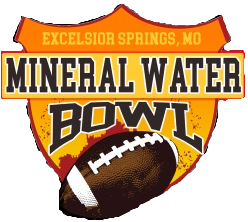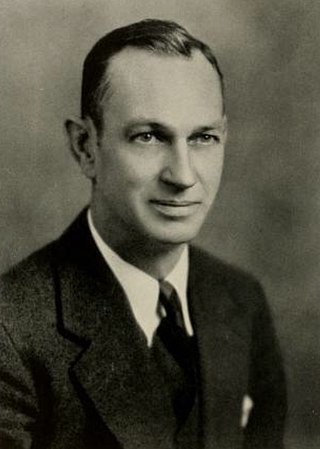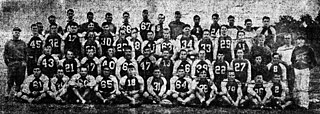
Donald Burrows Faurot was an American football and basketball player, coach, and college athletics administrator best known for his eight-decade association with the University of Missouri. He served as the head football coach at Northeast Missouri State Teachers College—commonly known at the time as Kirksville State Teachers College and now known as Truman State University—from 1926 to 1934 and at Missouri from 1935 to 1942 and again from 1946 to 1956. During World War II, Faurot coached the Iowa Pre-Flight Seahawks in 1943 and the football team at Naval Air Station Jacksonville in 1944. He was also the head basketball coach at Kirksville State from 1925 to 1934, tallying a mark of 92–74. Faurot was the athletic director at Missouri from 1935 to 1942 and again from 1946 to 1967. He lettered in three sports at Missouri in the early 1920s: in football, as a halfback, basketball and baseball.

The Mineral Water Bowl was an annual American NCAA Division II college football bowl game held in Excelsior Springs, Missouri at Tiger Stadium. Throughout its long history, the game was sponsored by the Quarterback Club, a civic organization in Excelsior Springs. At the time of its demise, it was one of four Division II sanctioned bowl games, along with the Live United Texarkana Bowl, the Heritage Bowl, and the America's Crossroads Bowl.
Donald Robert Anielak was an American professional basketball player and a high school coach. He starred at Southwest Missouri State University before playing professionally for the New York Knicks in 1954.

Richard A. "Ike" Eichhorst is an American retired professional basketball player from St. Louis, Missouri who played one game with the National Basketball Association (NBA) as a member of the St. Louis Hawks during the 1961–62 season. Eichhorst scored two points, had three assists, and grabbed one rebound in ten minutes of action. Eichhorst played college basketball for Southeast Missouri State University.
The 1940 Oregon Ducks football team represented the University of Oregon ass a member of the Pacific Coast Conference (PCC) during the 1940 college football season. In their third season under head coach Tex Oliver, the Ducks compiled a 4–4–1 record, and outscored their opponents, 100 to 58.
The 1935 Missouri Tigers football team was an American football team that represented the University of Missouri in the Big Six Conference during the 1935 college football season. The team compiled a 3–3–3 record, finished in sixth place in the Big 6, and outscored all opponents by a total of 97 to 77.

Raymond Rollins Sermon was an American college football, college basketball, college baseball, and track coach and college athletics administrator. He served as the head football coach at Central College—now known as Central Methodist University—in Fayette, Missouri in 1917 and Missouri School of Mines and Metallurgy—now known as Missouri University of Science and Technology—in Rolla, Missouri from 1918 to 1919, and Kirksville Osteopathy College—renamed from A.T. Still College of Osteopathy and Surgery in 1924 and now known as A.T. Still University—in Kirksville, Missouri from 1921 to 1924.
The 1977 South Dakota Coyotes football team represented the University of South Dakota in the 1977 NCAA Division II football season as a member of the North Central Conference (NCC). Led by third-year coach Beanie Cooper, the Coyotes compiled an overall record of 4–7 and a mark of 2–4–1 in conference play, tying for sixth place in the NCC. The team played two games against Nebraska–Omaha in order to save money on travel; each game counted as a half-game in the conference standings.
The 1934 Colorado Teachers Bears football team was an American football team that represented Colorado State Teachers College—now known as the University of Northern Colorado—as a member of the Rocky Mountain Conference (RMC) during the 1934 college football season. Led by third-year head coach John W. Hancock, the Bears compiled an overall record of 6–1 with an identical mark in conference play, sharing the RMC title with Colorado and Colorado Agricultural. The team outscored its opponents by a total of 148 to 31.
The 1946 Missouri Intercollegiate Athletic Association football season was the season of college football played by the six member schools of the Missouri Intercollegiate Athletic Association (MIAA) as part of the 1946 college football season.
The 1946 Central Intercollegiate Conference football season was the season of college football played by the six member schools of the Central Intercollegiate Conference (CIC) as part of the 1946 college football season.
The 1946 Michigan Intercollegiate Athletic Association football season was the season of college football played by the six member schools of the Michigan Intercollegiate Athletic Association (MIAA) as part of the 1946 college football season.
The 1940 Michigan Intercollegiate Athletic Association football season was the season of college football played by the six member schools of the Michigan Intercollegiate Athletic Association (MIAA) as part of the 1940 college football season.
The 1939 Missouri Intercollegiate Athletic Association football season was the season of college football played by the six member schools of the Missouri Intercollegiate Athletic Association (MIAA) as part of the 1939 college football season.
The 1931 Maryville Bearcats football team, also known as the Northwest Missouri State Teachers Bearcats, was an American football team that represented Northwest Missouri State Teachers College at Maryville, Missouri, as a member of the Missouri Intercollegiate Athletic Association (MIAA) during the 1931 college football season. In their fifth season under head coach Earl A. Davis, the Bearcats compiled a perfect 9–0 record, won the MIAA championship, shut out eight of nine opponents, and outscored all opponents by a total of 190 to 6.

The 1938 Maryville Bearcats football team, also known as the Northwest Missouri State Bearcats, was an American football team that represented Maryville State Teachers College at Maryville, Missouri, as a member of the Missouri Intercollegiate Athletic Association (MIAA) during the 1938 college football season. In their second season under head coach Ryland Milner, the Bearcats compiled a perfect 9–0 record, shut out six of nine opponents, outscored all opponents by a total of 221 to 26, and won the MIAA championship. Wilbur Stalcup was the assistant coach. The 1938 season was the start of a 21-game winning streak that ended in October 1940.
The 1933 Kirksville Bulldogs football team represented the Kirksville State Teachers College as a member of the Missouri Intercollegiate Athletic Association (MIAA) during the 1933 college football season. In their eighth year under head coach Don Faurot, the Bulldogs compiled a 9–0 record, won the MIAA championship, shut out five of nine opponents, and outscored all opponents by a total of 212 to 26.
The 1934 Kirksville Bulldogs football team represented the Kirksville State Teachers College as a member of the Missouri Intercollegiate Athletic Association (MIAA) during the 1934 college football season. In their ninth and final year under head coach Don Faurot, the Bulldogs compiled an 8–0 record, won the MIAA championship, shut out six of eight opponents, and outscored all opponents by a total of 180 to 13.
The 1932 Kirksville Bulldogs football team represented the Kirksville State Teachers College as a member of the Missouri Intercollegiate Athletic Association (MIAA) during the 1932 college football season. In their seventh year under head coach Don Faurot, the Bulldogs compiled an 8–0 record, won the MIAA championship, shut out six of eight opponents, and outscored all opponents by a total of 132 to 14. The 1932 season was part of a 27-game winning streak that included three consecutive perfect seasons in 1932, 1933, and 1934.
The 1936 Kirksville Bulldogs football team represented the Kirksville State Teachers College as a member of the Missouri Intercollegiate Athletic Association (MIAA) during the 1936 college football season. In their second year under head coach Fred Faurot, the Bulldogs compiled a 7–0 record, won the MIAA championship, and outscored opponents by a total of 79 to 29. It was Kirksville's fifth consecutive MIAA championship. The team had not lost a game against an MIAA opponent since 1931.





